> DRY
DRUNK
ALLEGORY AND FANTASY IN SMOKE
As early as 1525, the smoking of tobacco was described as something that
could "clarify the mind and give happy thoughts." In other words, tobacco
was, from the start, perceived as having a calming effect on the senses,
thereby allowing ample room for reverie –if not always the downright
abandon and physical collapse suggestive of the outer-body experience seen
in American Indian ritual. On the most basic level, tobacco was used to allegorize
one of the five senses, generally the sense of taste. Tobacco and the state
of contemplation associated with it also inspired some extraordinarily fanciful
images, in some of which the world is turned upside down, as when animals
drink, smoke, and play games like their human counterparts. The supernatural
world of witches and goblins also received some spirited additions, suggesting
new uses for the tobacco pipe, as did the more esoteric world of art, beauty,
and taste. Ornament prints too, which were used as models by artisans who
crafted objets de luxe like tobacco and snuff boxes, benefitted without question
from the craze for the divine herb.
The darker side of tobacco, and smoke in particular, did not fail to make
its presence known in allegories suggesting imminent danger and the inevitable
end of the world. Any ephemeral state or substance, from the fleetingly sweet
flesh of the strawberry to the passage of time pictured in an hourglass or
the snuffing out of a candle, was fair game for symbolizing the brevity of
life. The vaporous qualities of smoke, along with the fact that burning tobacco
leaves gave off nothing but disappearing smoke, some sooty residue, and a
bit of ash, made it eminently qualified to communicate this message.
91
John Nixon (British, ca. 1760–1818)
Smelling
Etching, published by William Wells, May 21, 1782
Arents Tobacco Collection
92
Hendrick Visjager (Dutch, active 1683–84)
De Smaeck [Taste]
Mezzotint, ca. 1683
Arents Tobacco Collection
93
Cornelis van Kittensteyn (Dutch, ca. 1597–1653) after Dirck Hals
(Dutch, 1591–1656)
The sense of taste
Engraving, 1623
Arents Tobacco Collection
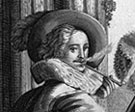 Allegorical print series depicting the five senses began to proliferate
in the 16th century, generally in a format that included a central female
personification of the sense, surrounded by attributes descriptive of it.
In the early decades of the 17th century, the genre transformed, with scenes
(more or less) from daily life. Along with the new format, new activities
and products were used to portray the old theme, such as the use of the newly
introduced and pungent-tasting herb tobacco to depict the sense of taste.
Allegorical print series depicting the five senses began to proliferate
in the 16th century, generally in a format that included a central female
personification of the sense, surrounded by attributes descriptive of it.
In the early decades of the 17th century, the genre transformed, with scenes
(more or less) from daily life. Along with the new format, new activities
and products were used to portray the old theme, such as the use of the newly
introduced and pungent-tasting herb tobacco to depict the sense of taste.
94
Unidentified (German, 1st quarter 18th century?)
The five senses
Etching, n.d.
Arents Tobacco Collection
The five senses are all represented in this composite of caricatured heads.
The sense of hearing blows a trumpet; turned upside down, the same head,
now representing the sense of sight, looks concertedly through his glasses;
their neighbor, the sense of smell, sniffs a rose. The pipe is used for the
senses of touch and smell: the pain from the bite of a mosquito makes the
smoking man drop his pipe upside down, which makes it possible for the dour-faced
sense of taste to smoke to his heart's content.
95
Adriaan de Winter (Dutch, active last quarter 17th century)
Fricasso and Franca Trippa and Cucurucu and Cap. Grillo
Etching and engraving, plates 5 and 6 from a series of Commedia dell'Arte characters,
n.d.
Print Collection, David McN. Stauffer Collection
Representing classic characters in Italian street theatre, de Winter borrowed
from his French predecessor, Jacques Callot, but added the rather curious
scene of Fricasso apparently blowing smoke in the direction of the adult-faced
baby on his back.
96
Coryn Boel (Flemish, 1620–1668)
after David Teniers the Younger (Flemish, 1610–1690) Pairs of
monkeys playing cards, drinking, making music, and smoking
Five etchings, n.d.
Print Collection, Cadwalader Fund
97
Jan van de Velde (Dutch, 1593–1641)
The Sorceress
Engraving, 1626
Print Collection, Kennedy Fund
 Van de Velde's inclusion of pipe-smoking goblins in his image of a nocturnal
witches' sabbath is a new twist on an old theme. The two tobacco pipes protruding
from the hind end of the spinning, midair figure at left spout an intriguing
luminous substance that adds to an already dynamic light show. In another
unusual twist that may reflect changing attitudes toward witches in 17th-century
Holland, this handmaiden to the devil is a sweet-looking, svelte figure rather
than an old hag.
Van de Velde's inclusion of pipe-smoking goblins in his image of a nocturnal
witches' sabbath is a new twist on an old theme. The two tobacco pipes protruding
from the hind end of the spinning, midair figure at left spout an intriguing
luminous substance that adds to an already dynamic light show. In another
unusual twist that may reflect changing attitudes toward witches in 17th-century
Holland, this handmaiden to the devil is a sweet-looking, svelte figure rather
than an old hag.
98
Johann Rudolf Schellenberg (Swiss, 1740–1806)
Pour Raillerie [All in mockery] Four etchings from a series of eight,
1772
Print Collection, Kennedy Fund
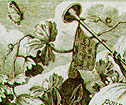
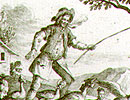
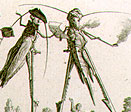
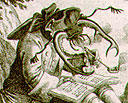
Schellenberg was, for the most part, a fairly lackluster printmaker,
but with this series of fanciful, mocking etchings he managed to turn the
world on its end in more ways than one. Tobacco figures prominently in three
plates in the series: first in the farmer, whose robust presence is enhanced
by the pipe; then in the turbanned grasshopper, where it emphasizes the exoticism
of his bizarre costume; finally, the beetle-poet's path to inspiration is
aided by the contemplative mood fostered by the pipe.
99
Pierre Bourdon (French, active in Paris 1st quarter 18th century)
Livre Troisième. Essais de Gravure . . . Où l'on voit de
beaux Contours d'ornemens traités dans le gout de l'Art, propre aux
Horlogeur[s], Orfêvres, Cizeleurs, Graveurs, et à toutes persones
curieuses [Third Book. Engraved samples . . . in which can be seen the handsome
outlines of ornaments treated with the artful taste proper to watchmakers,
goldsmiths, chasers, engravers and to all curious peoples]
Etching, ca. 1700
Print Collection, Harper Fund
100
William Hogarth (British, 1697–1764)
Time Smoking a Picture
Etching and aquatint, 1761
Print Collection, Bequest of Samuel J. Tilden
 This image, showing Father Time laying the dark hues of time onto the
canvas while his scythe jabs it, was a subscription print –a print
intended as a receipt for payment for a print yet to be published –for
a reproduction of his painting Sigismunda. In the end, the painted Sigismunda
was refused by its patron, and the print was never engraved. The negative
attitudes about the art world embedded within the subscription print would
seem to have borne truth. The underlying theme in Time Smoking is an attack
on the received notion that old pictures are the best: Hogarth, aiming to
promote contemporary art, his own included, argued instead that with time,
an artwork loses its original vitality, pigments fade, pictures get damaged
and darken.
This image, showing Father Time laying the dark hues of time onto the
canvas while his scythe jabs it, was a subscription print –a print
intended as a receipt for payment for a print yet to be published –for
a reproduction of his painting Sigismunda. In the end, the painted Sigismunda
was refused by its patron, and the print was never engraved. The negative
attitudes about the art world embedded within the subscription print would
seem to have borne truth. The underlying theme in Time Smoking is an attack
on the received notion that old pictures are the best: Hogarth, aiming to
promote contemporary art, his own included, argued instead that with time,
an artwork loses its original vitality, pigments fade, pictures get damaged
and darken.
101
William Hogarth (British, 1697–1764)
The Bathos, or Manner of Sinking in Sublime Paintings, inscribed to the Dealers
in Dark Pictures
Etching and engraving, 1764
Print Collection, Bequest of Samuel J. Tilden
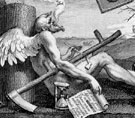 Intended by the artist quite literally as a "tailpiece" to a bound collection
of his printed works, this was also the last print he made. This conclusion
to Hogarth's art includes a just-broken tobacco pipe and a cloud of smoke
labelled "FINIS" within a gallery of other objects, all identifying death,
destruction, the end, including his last will and testament naming Chaos
as his executor, a broken column, one of his own prints going up in the flames
of a candle, Phaeton's chariot descending from the sky, etc., etc.
Intended by the artist quite literally as a "tailpiece" to a bound collection
of his printed works, this was also the last print he made. This conclusion
to Hogarth's art includes a just-broken tobacco pipe and a cloud of smoke
labelled "FINIS" within a gallery of other objects, all identifying death,
destruction, the end, including his last will and testament naming Chaos
as his executor, a broken column, one of his own prints going up in the flames
of a candle, Phaeton's chariot descending from the sky, etc., etc.







